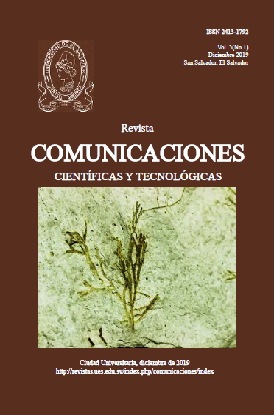Algas fósiles del sitio paleontológico La Gallina en El Salvador
Abstract
In 2015, a prospecting excavation was carried out due to the development of the San Miguel bypass. In this inspection the ravine called La Gallina was discovered in which the stratigraphy of the area is exposed, formed by a horizon bearing vegetable imprints in a shale matrix. The imprints host fragments of wood and twigs; in addition to leaves and seaweed. The paleontological site in question is located 600 meters from the main road that leads to the Department of La Unión, between 13 ° 26’56.10 “LN and 88 ° 6’46.98” LO. The floor bearing the imprints has a thickness of 1.20 meters and is constituted by whitish laminated shales and belongs to the member c1´l of the Cuscatlán Formation and Pleistocene age. The random way in which the fossils were found, the lack of evidence to determine the event responsible for the sedimentation of the body of water and the discovery that most of the algae imprints correspond to marine forms, represent an important challenge for the study about this imprints. The main objective was to determine the lowest possible taxon to which belong the algae found. The determination was consists in examining under the light of a binocular stereo microscope and high magnification magnifier, twenty-four seaweed imprints, to which they were make morphometric measurements and taxonomic identification character analysis that allow to be contrasted with the presented by the genera of current algae. The study determined that ten imprints belonged to green algae, of the genus aff. CodiumCodium, aff. , RhizocloniumRhizoclonium, , aff. CladophoraCladophora, aff. , NitellaNitella and aff. CladophoropsisCladophoropsis Twelve imprints corresponds to aff DictyotaDictyota a brown seaweed and two imprints have characteristics of red algae, of the order Gracilariales. By the type of algal flora found it can be inferred that in ancient times the paleontological site La Gallina was influenced by sea or brackish water. The information generated, will allow reconstruct the geological history of the area and the prevailing climatic conditions over a million years ago in the country.
Downloads
References
Abbott, I. A. 1999. Marine red algae of the Hawaiian Islands. Bishop Museum Press, Honolulu, Hawaii.
Abbott, I. A., and J. M. Huisman. 2004. Marine green and brown algae of the Hawaiian Islands. Bishop Museum Press, Honolulu, Hawaii.
Baxter, S., 1985. Léxico Estratigráfico de El Salvador. Comisión Hidroeléctrica del Río Lempa, CEL. 128 pp.
Bengtson S, Sallstedt T, Belivanova V, Whitehouse M (2017) Three-dimensional preservation of cellular and subcellular structures suggests 1.6 billion-year-old crown-group red algae. PLoS Biol 15(3): e2000735.doi:10.1371/ journal.pbio.2000735
Fernández García C. 2012. Taxonomía y biogeografía de las familias Caulerpaceae
(Chlorophyta), Dictyotaceae (Ochrophyta) y Corallinaceae (Rhodophyta) en el Pacífico de Centroamérica. Tesis para optar al grado de Doctor en Ciencias Marinas y Costeras.
Graham L.E, Graham J.M; Wilcox L.W y Cook M.E. 2016. Algae. 3ª Ed. LJLM Press.
Guiry, M. D., Guiry, M. D. & Guiry, G. M. (2019). AlgaeBase. World-wide elec-tronic publication, National Universi¬ty of Ireland, Galway. Recuperado en mayo 08, 2019, disponible en http:// www.algaebase.org.
Hernández, W., 2005: Nacimiento y Desarrollo del Río Lempa. Servicio Nacional de Estudios Territoriales de El Salvador, Ministerio del Ambiente y Recursos Naturales.
Lee, R.E. 2008. Phycology. 4ª Ed. Cambridge University Press.
Norris, J.N. 2010. Marine algae of the Northern Gulf of California: Chlorophyta and Phaeophyceae. Smith. Contr. Bot. 94: 1-276.
Ortega M. 1984. Catálogo de algas continentales recientes de México. Coordinación de la Investigación Científica, Instituto de Biología, Universidad Nacional Autónoma de México 565 pp.
Rivera Charún M. L. 2019. Identificación y determinación de carofitas fósiles de las formaciones del cretáceo superior y paleoceno inferior. Región Cusco. Tesis. Universidad Ricardo Palma. Perú.
Schnetter, R. & Bula-Meyer, G. 1982. Marine Algen der Pazifikki.iste von Kolombien: Chlorophyceae. Bibliotheca Phycologia. 287 pp.
Taylor, W. R. (1945). Pacific Marine Algae of the Allan Hancock Expedition to the Galapagos Islands.: University of Southern California Press, Los Angeles California.
Taylor, W. R. (1960). Marine Algae of the Eastern Tropical and Subtropical Coasts of the Americas. Michigan, EE. UU.: University of Michigan Press.
Downloads
Published
How to Cite
Issue
Section
License
Copyright (c) 2021 Olga Lidia Tejada, Daniel Isaí Alvarenga

This work is licensed under a Creative Commons Attribution-NonCommercial 4.0 International License.






